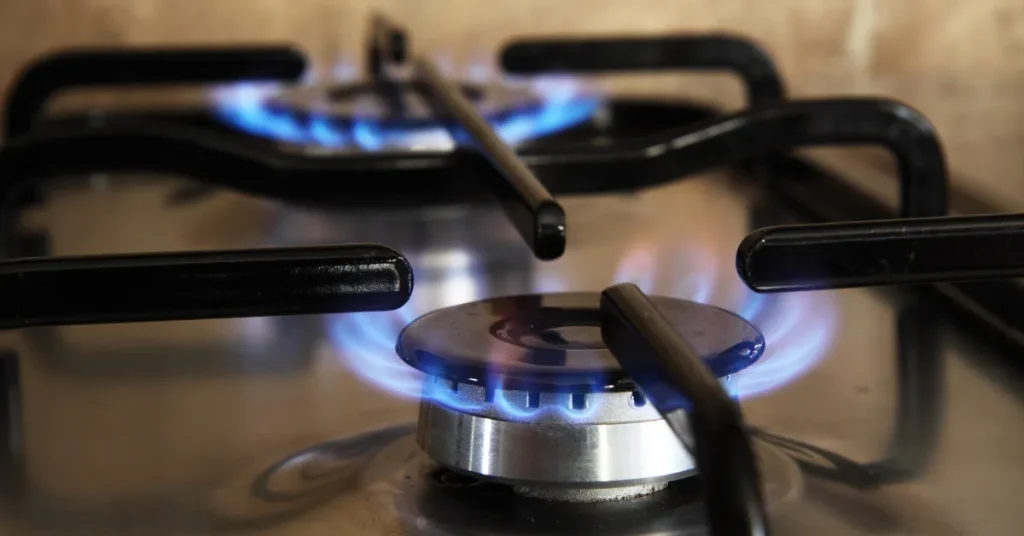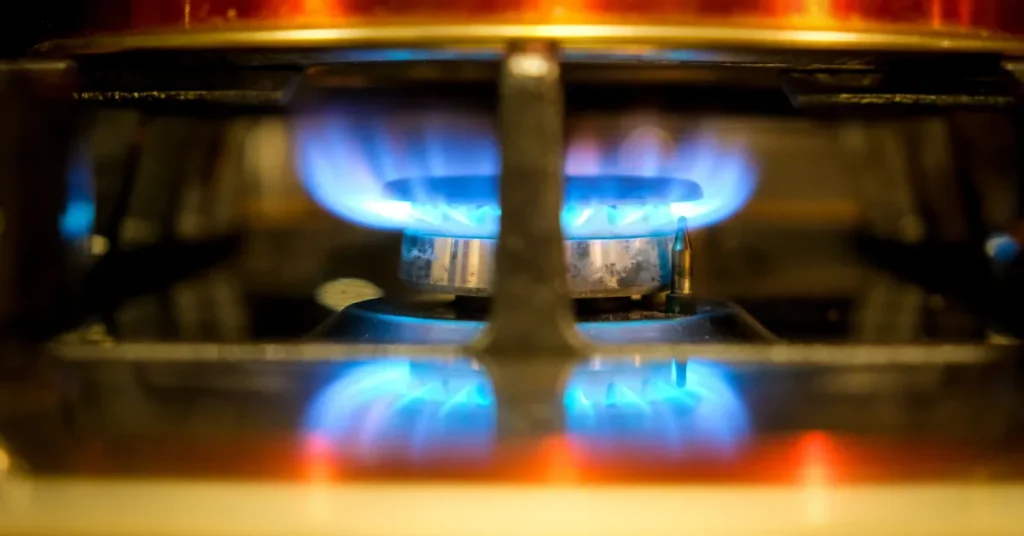The average depth of a stove is about 25 to 27 inches. This standard size aligns with the depth of most kitchen countertops.
In the quest to optimize kitchen space, understanding the dimensions of appliances is crucial. Stoves, or ranges, are pivotal in kitchen layout planning due to their relatively large size and central role in cooking activities.
Optimal stove depth ensures seamless countertop alignment for a sleek and functional kitchen design.
Homeowners and designers must consider the depth of the stove to maintain a harmonious kitchen workspace.
With various stove designs available, from slide-in to freestanding models, the depth can slightly vary, but it usually adheres to the average measurement to accommodate kitchen cabinetry and provide ease of installation.
Whether upgrading your kitchen or installing a new stove, considering its depth is essential for achieving a streamlined look and efficient kitchen flow.

Starting With Stove Dimensions
When outfitting a kitchen, understanding stove dimensions is essential. It’s more than just width and height—stove depth plays a crucial role in kitchen design. Depth influences how a stove fits in the space, aligns with countertops, and integrates with the overall flow of the kitchen. Let’s delve into standard depths and how they vary across different stove types.
Standard Stove Depths
The average depth of a stove typically measures between 24 to 29 inches. This size ensures that the appliance will align neatly with standard kitchen counters.
Not all kitchens are the same. Measuring the available space before purchasing is vital.
| Stove Type | Average Depth (inches) |
| Freestanding | 25-29 |
| Slide-in | 24-29 |
| Drop-in | 28-30 |
Variations By Stove Type
Depths can differ based on the type of stove chosen. Custom kitchens often feature unique dimensions and may require a stove with non-standard depth.
- Freestanding stoves typically have slightly greater depths to accommodate controls at the back.
- Slide-in units are designed to fit flush with countertops, offering a streamlined look.
- Drop-in stoves often feature a deeper fit, sitting atop cabinets rather than between them.
Always verify exact dimensions with the manufacturer. This will ensure the perfect fit for your space and needs.
Measuring Stove Depth

Knowing the depth of your stove is crucial when remodeling your kitchen or buying new appliances. Measurement ensures a perfect fit for your space.
Proper tools and techniques yield precision. Let’s explore how to measure stove depth correctly.
Tools For Accurate Measurements
To start, gather the right tools for precise measurements:
- Tape measure: Ensure it’s long enough to measure the stove’s full depth.
- Notepad and pen: Record your measurements immediately to avoid errors.
- Level: Check the stove is even from front to back.
Step-by-step Measuring Guide
- Prepare the area. Clear the stove’s front and sides.
- Place the level. Ensure your stove is level before measuring.
- Measure from back to front. Extend the tape measure from the wall to the stove’s front edge.
- Include protrusions. Account for knobs or handles.
- Record the number. Write it down to the nearest eighth of an inch.
Remember to check the distance twice for accuracy. Double-checking avoids mistakes and ensures a perfect kitchen fit.
Factors Influencing Stove Depth
Factors Influencing Stove Depth vary widely, shaping kitchen design and functionality. Understanding these factors ensures a seamless integration into your kitchen space.
From sleek models to robust units, stove depth plays a pivotal role in kitchen aesthetics and practicality.
Design Considerations
The design of a stove significantly dictates its depth. Designers balance visual appeal with ergonomic standards.
Style trends, like minimalist kitchens, often feature slimmer stoves to maintain clean lines. Conversely, stoves with a retro design may exhibit more depth, contributing to their vintage charm.
Functional Utility
Functional utility is paramount when determining the ideal stove depth. Deep stoves offer larger cooking areas, accommodating multiple pots and pans.
Cooking habits influence stove selection; frequent entertainers or large families might opt for deeper models. Meanwhile, compact stoves fit into smaller spaces, suited for solo dwellers or minimal use.
Installation Constraints
Installation space sets crucial constraints on stove depth. Standard cabinetry often aligns with appliances measuring 24 to 26 inches deep.
Stoves should also match the countertop depth for a flush fit, promoting a streamlined kitchen profile. Pre-existing gas or electrical connections may also limit placement options and consequently, stove depth choices.
| Dimension | Standard Depth | Notes |
| Cabinetry | 24″-26″ | Aligns with standard stoves |
| Countertop | 25-30 inches | Varies with design |
| Professional Models | Up to 30″ | For robust cooking needs |
Impact Of Depth On Kitchen Layout
Choosing the right stove depth is crucial for a harmonious kitchen layout. It affects everything from traffic flow to aesthetics. Let’s explore the impact of depth designs on kitchen spaces.
Space Planning
Proper space planning ensures efficiency and comfort in the kitchen.
- A standard stove depth aligns with most kitchen counter depths, creating a seamless look.
- Varying depths need careful measurement to avoid protruding appliances.
- Deep stoves may require additional aisle space for safety and convenience.
Integration With Countertops And Cabinetry
Stoves need to integrate seamlessly with countertops and cabinetry to optimize kitchen function.
Consider the following:
| Depth Factor | Consideration |
| Counter alignment | Ensures a consistent and tidy appearance. |
| Cabinet clearance | Prevents heat damage and maintains accessibility. |
| Appliance size | Influences the layout of surrounding areas. |
Ergonomics And Accessibility
Stove depth affects usability for all family members.
- A shallow stove offers easier reach for children and those with limited mobility.
- Deeper models may provide more cooking area but can be less accessible.
- Correct stove height and depth combination reduces strain during meal preparation.
Selecting The Right Stove Depth
Embarking on the journey of kitchen renovation or stove replacement means making key decisions about appliance dimensions. Selecting the Right Stove Depth is crucial for your kitchen’s functionality and flow.
Ensuring that your new cooking appliance fits seamlessly into your kitchen layout enhances both usability and aesthetics.
Matching Depth With Cooking Needs
Understand your culinary habits before choosing a stove depth. Consider these points:
- Regular use: Opt for standard depth if you cook often.
- Large cookware: Deeper stoves accommodate bigger pots and pans.
- Volume cooking: More depth means extra surface area for multiple dishes.
Standard stoves typically measure 24 to 30 inches deep. Professional-grade models may extend beyond this range.
Considering Kitchen Size
Kitchen dimensions dictate stove depth:
| Kitchen Size | Recommended Stove Depth |
| Small | 24 inches – 30 inches |
| Medium to Large | More flexible, up to 36 inches or beyond |
Measure the available space to avoid a cramped layout. Allow for clearance space around the stove area for safety and comfort.
Balancing Aesthetics And Function
Aesthetic preference plays a role in stove depth choice:
- Flush fit: Aligns with cabinetry for a sleek look.
- Protruding: Sticks out slightly, often chosen for style.
Cohesion between appliances is visually pleasing. Function should not take a backseat. Prioritize efficient venting and easy access to controls.
Faqs On Stove Depths

Are you curious about how deep your stove should be? Understanding stove depth is crucial for kitchen design. Here, we have compiled a list of frequently asked questions to help guide you through the essentials of stove dimensions.
Common Questions
- What is the standard depth of a stove?
- Can stoves be deeper than countertops?
- Are there stoves designed for small kitchens?
Expert Answers
Standard stove depth often matches common countertop depth, which is typically 25 to 26 inches.
| Measurement | Depth |
| Standard | 25-26 inches |
| Countertop | 24 inches |
| Compact Stoves | 20-24 inches |
Some stoves are indeed deeper than countertops, particularly professional models that may extend up to 28 inches or more.
- Measure kitchen space before selecting a stove.
- Consider stove and kitchen layout compatibility.
- Explore compact or slim stove options for smaller kitchens.
For tight spaces, look for compact stoves. They range from 20 to 24 inches deep and fit small kitchen designs well.
FAQs About How Deep Is A Stove
What Is The Standard Depth Of Stoves?
Standard stove depths usually range from 24 to 26 inches. However, this can vary depending on the model and brand. Pro-style or commercial stoves may exceed 26 inches to accommodate larger capacities and features.
How Do Stove Depths Impact Kitchen Design?
Stove depth is crucial for kitchen design, ensuring seamless countertop alignment and aesthetic coherence. Proper integration also affects kitchen workflow and safety, with deeper stoves possibly requiring additional space for proper ventilation and user comfort.
Can Stoves Be Deeper Than Countertops?
Yes, some stoves are deeper than the average countertop depth of 24 inches. It’s important to check stove specifications for compatibility with existing countertops and consider any potential overhang before making a purchase.
Are There Slim-depth Stove Options Available?
Slim-depth stoves are available for compact kitchen spaces, typically measuring around 20 inches deep. These models are designed to fit into tighter areas while still providing essential functionality.
Conclusion
Understanding stove depth is essential for kitchen design and appliance compatibility. It varies by model and configuration, typically ranging from 24 to 29 inches.
Remember to measure your space accurately to ensure a perfect fit. Selecting the right depth will enhance your cooking experience and kitchen functionality.
Resources:
1. https://www.epa.gov/burnwise/choosing-right-wood-burning-stove
